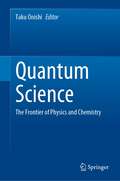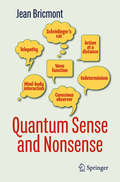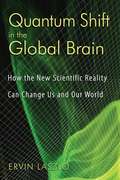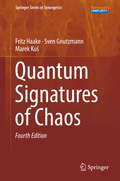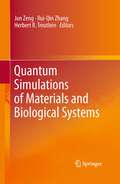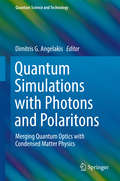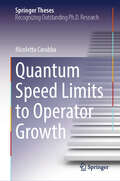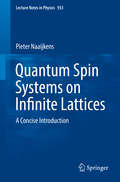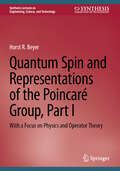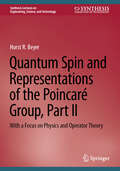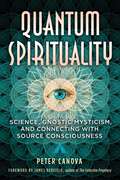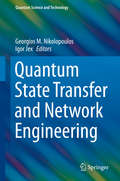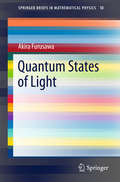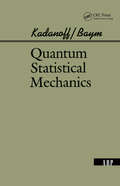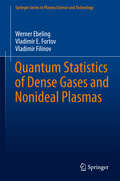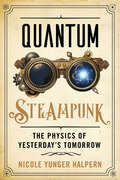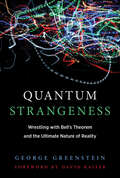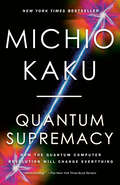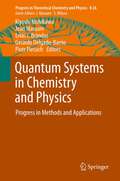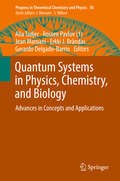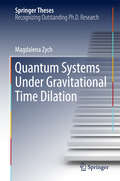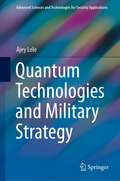- Table View
- List View
Quantum Science: The Frontier of Physics and Chemistry
by Taku OnishiThis book focuses on recent topics of quantum science in both physics and chemistry. Until now, quantum science has not been fully discussed from the interdisciplinary vantage points of both physics and chemistry. This book, however, is written not only for theoretical physicists and chemists, but also for experimentalists in the fields of physical chemistry and condensed matter physics, as collaboration and interplay between construction of quantum theory, and experimentation has become more important. Tips for starting new types of research projects will be found in an understanding of cutting-edge quantum science. In Part I, quantum electronic structures are explained in cases of strongly correlated copper oxides and heavy elements. In Part II, quantum molecular dynamics is investigated by computational approaches and molecular beam experiments. In Part III, after lithium problem in big bang nucleosynthesis scenario is considered using supersymmetric standard model, quantum theories in atomic and molecular systems are reviewed. Finally, in Part IV, the development of quantum computational method is introduced.
Quantum Sense and Nonsense
by Jean BricmontPermeated by the author's delightful humor, this little book explains, with nearly no mathematics, the main conceptual issues associated with quantum mechanics: The issue of determinism. Does quantum mechanics signify the end of a deterministic word-view? The role of the human subject or of the "observer" in science. Since Copernicus, science has increasingly tended to dethrone Man from his formerly held special position in the Universe. But quantum mechanics, with its emphasis on the notion of observation, may once more have given a central role to the human subject. The issue of locality. Does quantum mechanics imply that instantaneous actions at a distance exist in Nature? In these pages the author offers a variety of views and answers - bad as well as good - to these questions. The reader will be both entertained and enlightened by Jean Bricmont's clear and incisive arguments.
Quantum Shift in the Global Brain: How the New Scientific Reality Can Change Us and Our World
by Ervin LaszloThe shift from scientific materialism to a multidimensional worldview in harmony with the world’s great spiritual traditions• Articulates humanity’s critical choice--to be the last decade of an outgoing, obsolete world, or the first of a new and viable one• Presents a new “reality map” to guide us through the environmental, scientific, and geopolitical upheavals we are experiencingOur world is in a Macroshift. The reality we are experiencing today is a substantially new reality--climate change, global corporations, industrialized agriculture--challenging us to change with our rapidly changing world, lest we perish. In this book, Ervin Laszlo presents a new “reality map” to guide us through the world shifts we are experiencing--the problems, opportunities, and challenges we face individually as well as collectively--in order to help us understand what we must do during this time of great transition. Science’s cutting edge now views reality as broader, as multiple universes arising in a possibly infinite meta-universe, as well as deeper, extending into dimensions at the subatomic level. Laszlo shows that aspects of human experience that had previously been consigned to the domain of intuition and speculation are now being explored with scientific rigor and urgency. There has been a shift in the materialistic scientific view of reality toward the multidimensional worldview of multiple interconnected realities long known by the world’s great spiritual traditions. By understanding the interconnectedness of our changing world as well as our changing “map” of the world, we can navigate with insight, wisdom, and confidence.
Quantum Signatures of Chaos (Springer Series in Synergetics #Vol. 54)
by Fritz Haake Sven Gnutzmann Marek KuśThis by now classic text provides an excellent introduction to and survey of the still-expanding field of quantum chaos. For this long-awaited fourth edition, the original text has been thoroughly modernized. <P><P> The topics include a brief introduction to classical Hamiltonian chaos, a detailed exploration of the quantum aspects of nonlinear dynamics, quantum criteria used to distinguish regular and irregular motion, and antiunitary (generalized time reversal) and unitary symmetries. The standard Wigner-Dyson symmetry classes, as well as the non-standard ones introduced by Altland and Zirnbauer, are investigated and illustrated with numerous examples. Random matrix theory is presented in terms of both classic methods and the supersymmetric sigma model. The power of the latter method is revealed by applications outside random-matrix theory, such as to quantum localization, quantum graphs, and universal spectral fluctuations of individual chaotic dynamics. The equivalence of the sigma model and Gutzwiller’s semiclassical periodic-orbit theory is demonstrated. Last but not least, the quantum mechanics of dissipative chaotic systems are also briefly described. <P><P> Each chapter is accompanied by a selection of problems that will help newcomers test and deepen their understanding, and gain a firm command of the methods presented.
Quantum Simulations of Materials and Biological Systems
by Rui-Qin Zhang Jun Zeng Herbert TreutleinQuantum Simulations of Materials and Biological Systems features contributions from leading world experts in the fields of density functional theory (DFT) and its applications to material and biological systems. The recent developments of correlation functionals, implementations of Time-dependent algorithm into DFTB+ method are presented. The applications of DFT method to large materials and biological systems such as understanding of optical and electronic properties of nanoparticles, X-ray structure refinement of proteins, the catalytic process of enzymes and photochemistry of phytochromes are detailed. In addition, the book reviews the recent developments of methods for protein design and engineering, as well as ligand-based drug design. Some insightful information about the 2011 International Symposium on Computational Sciences is also provided. Quantum Simulations of Materials and Biological Systems is aimed at faculties and researchers in the fields of computational physics, chemistry and biology, as well as at the biotech and pharmaceutical industries.
Quantum Simulations with Photons and Polaritons
by Dimitris G. AngelakisThis book reviews progress towards quantum simulators based on photonic and hybrid light-matter systems, covering theoretical proposals and recent experimental work. Quantum simulators are specially designed quantum computers. Their main aim is to simulate and understand complex and inaccessible quantum many-body phenomena found or predicted in condensed matter physics, materials science and exotic quantum field theories. Applications will include the engineering of smart materials, robust optical or electronic circuits, deciphering quantum chemistry and even the design of drugs. Technological developments in the fields of interfacing light and matter, especially in many-body quantum optics, have motivated recent proposals for quantum simulators based on strongly correlated photons and polaritons generated in hybrid light-matter systems. The latter have complementary strengths to cold atom and ion based simulators and they can probe for example out of equilibrium phenomena in a natural driven-dissipative setting. This book covers some of the most important works in this area reviewing the proposal for Mott transitions and Luttinger liquid physics with light, to simulating interacting relativistic theories, topological insulators and gauge field physics. The stage of the field now is at a point where on top of the numerous theory proposals; experiments are also reported. Connecting to the theory proposals presented in the chapters, the main experimental quantum technology platforms developed from groups worldwide to realize photonic and polaritonic simulators in the laboratory are also discussed. These include coupled microwave resonator arrays in superconducting circuits, semiconductor based polariton systems, and integrated quantum photonic chips. This is the first book dedicated to photonic approaches to quantum simulation, reviewing the fundamentals for the researcher new to the field, and providing a complete reference for the graduate student starting or already undergoing PhD studies in this area.
Quantum Social Science
by Emmanuel Haven Andrei KhrennikovWritten by world experts in the foundations of quantum mechanics and its applications to social science, this book shows how elementary quantum mechanical principles can be applied to decision-making paradoxes in psychology and used in modelling information in finance and economics. The book starts with a thorough overview of some of the salient differences between classical, statistical and quantum mechanics. It presents arguments on why quantum mechanics can be applied outside of physics and defines quantum social science. The issue of the existence of quantum probabilistic effects in psychology, economics and finance is addressed and basic questions and answers are provided. Aimed at researchers in economics and psychology, as well as physics, basic mathematical preliminaries and elementary concepts from quantum mechanics are defined in a self-contained way.
Quantum Speed Limits to Operator Growth (Springer Theses)
by Nicoletta CarabbaThis book introduces universal bounds to quantum unitary dynamics, with applications ranging from condensed matter models to quantum metrology and computation. Motivated by the observation that the dynamics of many-body systems can be better unraveled in the Heisenberg picture, we focus on the unitary evolution of quantum observables, a process known as operator growth and quantified by the Krylov complexity. By means of a generalized uncertainty relation, we constrain the complexity growth through a universal speed limit named the dispersion bound, investigating also its relation with quantum chaos. Furthermore, the book extends the framework of quantum speed limits (QSLs) to operator flows, identifying new fundamental timescales of physical processes. Crucially, the dynamics of operator complexity attains the QSL whenever the dispersion bound is saturated. Our results provide computable constraints on the linear response of many-body systems out of equilibrium and the quantum Fisher information governing the precision of quantum measurements.
Quantum Spin Systems on Infinite Lattices
by Pieter NaaijkensThis course-based primer offers readers a concise introduction to the description of quantum mechanical systems with infinitely many degrees of freedom - and quantum spin systems in particular - using the operator algebraic approach. Here, the observables are modeled using elements of some operator algebra, usually a C*-algebra. This text introduces readers to the framework and the necessary mathematical tools without assuming much mathematical background, making it more accessible than advanced monographs. The book also highlights the usefulness of the so-called thermodynamic limit of quantum spin systems, which is the limit of infinite system size. For example, this makes it possible to clearly distinguish between local and global properties, without having to keep track of the system size. Together with Lieb-Robinson bounds, which play a similar role in quantum spin systems to that of the speed of light in relativistic theories, this approach allows ideas from relativistic field theories to be implemented in a quantum spin system. Several related cases are discussed, demonstrating the merits of the operator algebraic approach. Featuring representative worked-out examples and many exercises, this text is primarily targeted at graduate students and advanced undergraduates in theoretical physics or mathematics with a keen interest in mathematical physics. The material provides the necessary background and pointers to start exploring the recent literature. As such, it will also be useful for active researchers seeking a quick and comparatively self-contained introduction to the operator algebraic approach to quantum spin systems.
Quantum Spin and Representations of the Poincaré Group, Part I: With a Focus on Physics and Operator Theory (Synthesis Lectures on Engineering, Science, and Technology)
by Horst R. BeyerThis book discusses how relativistic quantum field theories must transform under strongly continuous unitary representations of the Poincaré group. The focus is on the construction of the representations that provide the basis for the formulation of current relativistic quantum field theories of scalar fields, the Dirac field, and the electromagnetic field. Such construction is tied to the use of the methods of operator theory that also provide the basis for the formulation of quantum mechanics, up to the interpretation of the measurement process. In addition, since representation spaces of primary interest in quantum theory are infinite dimensional, the use of these methods is essential. Consequently, the book also calculates the generators of relevant strongly continuous one-parameter groups that are associated with the representations and, where appropriate, the corresponding spectrum. Part I of Quantum Spin and Representations of the Poincaré Group specifically addresses: conventions; basic properties of SO(2) and SO(3); construction of a double cover of SO(3); SU(2) spinors; continuous unitary representation of SU(2); basic properties of the Lorentz Group; unitary representation of the restricted Lorentz Group; an extension to a strongly continuous representation of the restricted Poincaré Group; and an extension to a unitary/anti-unitary representation of the Poincaré Group.
Quantum Spin and Representations of the Poincaré Group, Part II: With a Focus on Physics and Operator Theory (Synthesis Lectures on Engineering, Science, and Technology)
by Horst R. BeyerThis book discusses how relativistic quantum field theories must transform under strongly continuous unitary representations of the Poincaré group. The focus is on the construction of the representations that provide the basis for the formulation of current relativistic quantum field theories of scalar fields, the Dirac field, and the electromagnetic field. Such construction is tied to the use of the methods of operator theory that also provide the basis for the formulation of quantum mechanics, up to the interpretation of the measurement process. In addition, since representation spaces of primary interest in quantum theory are infinite dimensional, the use of these methods is essential. Consequently, the book also calculates the generators of relevant strongly continuous one-parameter groups that are associated with the representations and, where appropriate, the corresponding spectrum. Part II of Quantum Spin and Representations of the Poincaré Group specifically addresses: construction of a double cover of the restricted Lorentz Group; Weyl spinors; Weyl representation of SL(2, C); an extension to a strongly continuous representation of a semi-direct product of R^4 and SL(2, C); Dirac spinors; Dirac fields; Dirac equation; Spin 1 representations of SL(2, C); Maxwell fields; and Maxwell's equations.
Quantum Spirituality: Science, Gnostic Mysticism, and Connecting with Source Consciousness
by Peter CanovaReveals how ancient Gnostic teachings predicted modern quantum physics• Explains how the perennial principles of Gnosticism, a repository of Judeo-Christian mysticism, describe major theories of quantum physics, such as the Big Bang, parallel universes, the Holographic Universe theory, and Einstein&’s Relativity• Shows how these teachings reveal consciousness as the creator of reality• Reveals how to harness quantum spirituality for personal empowerment, access to higher levels of consciousness, and manifestationFrom the dawn of history, a universal wisdom tradition has existed that explains humanity&’s purpose in the cosmos and our relationship to the Master Source Consciousness. This mystical philosophy was harnessed by the ancient seers known as Gnostics, who were in direct contact with Source Consciousness. As Peter Canova reveals, not only do the ancient teachings of Gnosticism contain important spiritual truths, but they profoundly align with the modern sciences of quantum physics and psychology. They can also provide us with a transformative path to higher consciousness and practical tools to create your own reality. Merging modern science and ancient wisdom, Canova explores the perennial principles of Gnosticism and shows how they describe major theories of quantum physics, such as the Big Bang, parallel universes, the Holographic Universe theory, and Einstein&’s Relativity. He recounts the Gnostic story of Sophia from a scientific standpoint, showing how it describes the fall of spiritual consciousness into material existence. He also provides in-depth evidence that Jesus taught a hidden, mystical Gnostic initiation rite. Explaining how the Master Consciousness created and shaped all life, including humans, the author reveals how Source gave us a critical role to fulfill in the cosmos, including the ability of our thoughts to affect the material world. He describes Carl Jung&’s role in the spiritualization of psychology and how this can be used by the modern spiritual seeker to pursue a path of enlightenment and personal fulfillment. Ultimately showing how enlightenment is a process wherein outer manifestations arise from inner experience--including synchronicity and dreams--the author reveals how each of us can harness the power of quantum spirituality to transform our world on both an individual and collective level.
Quantum State Transfer and Network Engineering
by Georgios M. Nikolopoulos Igor JexFaithful communication is a necessary precondition for large-scale quantum information processing and networking, irrespective of the physical platform. Thus, the problems of quantum-state transfer and quantum-network engineering have attracted enormous interest over the last years, and constitute one of the most active areas of research in quantum information processing. The present volume introduces the reader to fundamental concepts and various aspects of this exciting research area, including links to other related areas and problems. The implementation of state-transfer schemes and the engineering of quantum networks are discussed in the framework of various quantum optical and condensed matter systems, emphasizing the interdisciplinary character of the research area. Each chapter is a review of theoretical or experimental achievements on a particular topic, written by leading scientists in the field. The volume aims at both newcomers as well as experienced researchers.
Quantum States of Light
by Akira FurusawaThis book explains what quantum states of light look like. Of special interest, a single photon state is explained by using a wave picture, showing that it corresponds to the complementarity of a quantum. Also explained is how light waves are created by photons, again corresponding to the complementarity of a quantum. The author shows how an optical wave is created by superposition of a "vacuum" and a single photon as a typical example. Moreover, squeezed states of light are explained as "longitudinal" waves of light and Schrödinger's cat states as macroscopic superposition states.
Quantum Statistical Mechanics (Advanced Books Classics Ser.)
by Leo P. KadanoffGreen's Function Methods in Equilibrium and Nonequilibrium Problems
Quantum Statistics of Dense Gases and Nonideal Plasmas
by Werner Ebeling Vladimir E. Fortov Vladimir FilinovThe aim of this book is the pedagogical exploration of the basic principles of quantum-statistical thermodynamics as applied to various states of matter - ranging from rare gases to astrophysical matter with high-energy density. The reader will learn in this work that thermodynamics and quantum statistics are still the concepts on which even the most advanced research is operating - despite of a flood of modern concepts, classical entities like temperature, pressure, energy and entropy are shown to remain fundamental. The physics of gases, plasmas and high-energy density matter is still a growing field and even though solids and liquids dominate our daily life, more than 99 percent of the visible Universe is in the state of gases and plasmas and the overwhelming part of matter exists at extreme conditions connected with very large energy densities, such as in the interior of stars. This text, combining material from lectures and advanced seminars given by the authors over many decades, is a must-have introduction and reference for both newcomers and seasoned researchers alike.
Quantum Steampunk: The Physics of Yesterday's Tomorrow
by Nicole Yunger HalpernThe Industrial Revolution meets the quantum-technology revolution! A steampunk adventure guide to how mind-blowing quantum physics is transforming our understanding of information and energy.Victorian era steam engines and particle physics may seem worlds (as well as centuries) apart, yet a new branch of science, quantum thermodynamics, reenvisions the scientific underpinnings of the Industrial Revolution through the lens of today's roaring quantum information revolution. Classical thermodynamics, understood as the study of engines, energy, and efficiency, needs reimagining to take advantage of quantum mechanics, the basic framework that explores the nature of reality by peering at minute matters, down to the momentum of a single particle. In her exciting new book, intrepid Harvard-trained physicist Dr. Nicole Yunger Halpern introduces these concepts to the uninitiated with what she calls "quantum steampunk," after the fantastical genre that pairs futuristic technologies with Victorian sensibilities. While readers follow the adventures of a rag-tag steampunk crew on trains, dirigibles, and automobiles, they explore questions such as, "Can quantum physics revolutionize engines?" and "What deeper secrets can quantum information reveal about the trajectory of time?" Yunger Halpern also describes her own adventures in the quantum universe and provides an insider's look at the work of the scientists obsessed with its technological promise. Moving from fundamental physics to cutting-edge experimental applications, Quantum Steampunk explores the field's aesthetic, shares its whimsy, and gazes into the potential of a quantum future. The result is a blast for fans of science, science fiction, and fantasy.
Quantum Stochastics
by Mou-Hsiung ChangThe classical probability theory initiated by Kolmogorov and its quantum counterpart, pioneered by von Neumann, were created at about the same time in the 1930s, but development of the quantum theory has trailed far behind. Although highly appealing, the quantum theory has a steep learning curve, requiring tools from both probability and analysis and a facility for combining the two viewpoints. This book is a systematic, self-contained account of the core of quantum probability and quantum stochastic processes for graduate students and researchers. The only assumed background is knowledge of the basic theory of Hilbert spaces, bounded linear operators, and classical Markov processes. From there, the book introduces additional tools from analysis, and then builds the quantum probability framework needed to support applications to quantum control and quantum information and communication. These include quantum noise, quantum stochastic calculus, stochastic quantum differential equations, quantum Markov semigroups and processes, and large-time asymptotic behavior of quantum Markov semigroups.
Quantum Strangeness: Wrestling with Bell's Theorem and the Ultimate Nature of Reality (The\mit Press Ser.)
by George S. GreensteinA physicist's efforts to understand the enigma that is quantum mechanics.Quantum mechanics is one of the glories of our age. The theory lies at the heart of modern society. Quantum mechanics is one of our most valuable forecasters—a “great predictor.” It has immeasurably altered our conception of the natural world. Its philosophical implications are earthshaking. But quantum mechanics steadfastly refuses to speak of many things; it deals in probabilities rather than giving explicit descriptions. It never explains. Einstein, one of its creators, considered the theory incomplete. Even now, many years after the creation of quantum mechanics, physicists continue to argue about it. Astrophysicist George Greenstein has been both fascinated and confused by quantum mechanics for his entire career. In this book, he describes, engagingly and accessibly, his efforts to understand the enigma that is quantum mechanics. The fastest route to the insight into the ultimate nature of reality revealed by quantum mechanics, Greenstein writes, is through Bell's Theorem, which concerns reality at the quantum level; and Bell's 1964 discovery drives Greenstein's quest. Greenstein recounts a scientific odyssey that begins with Einstein, continues with Bell, and culminates with today's push to develop an industry of quantum machines. Along the way, he discusses spin, entanglement, experimental metaphysics, and quantum teleportation, often with easy-to-grasp analogies. We have known for decades that the world of the quantum was strange, but, Greenstein says, not until John Bell came along did we know just how strange.
Quantum Superfield Supersymmetry (Fundamental Theories of Physics #202)
by Albert PetrovThis book presents the superfield description of various supersymmetric field theory models in three- and four-dimensional space-times. A mapping between superfield and component formulations of supersymmetric field theories is discussed. The author also describes the methodology for calculating quantum corrections in these theories employing supergraph formalism and functional methods, and illustrates these approaches with many detailed examples of how such calculations are performed for various superfield models.
Quantum Supremacy: How the Quantum Computer Revolution Will Change Everything
by Michio KakuNEW YORK TIMES BESTSELLER • An exhilarating tour of humanity's next great technological achievement—quantum computing—which may supercharge artificial intelligence, solve some of humanity's biggest problems, like global warming, world hunger, and incurable disease, and eventually illuminate the deepest mysteries of science, by the bestselling author of The God Equation. • &“Expertly describes and rectifies common misconceptions about quantum computing." —Science "[Kaku's] lucid prose and thought process make abundant sense of this technological turning point.&” —The New York Times Book ReviewThe runaway success of the microchip may finally be reaching its end. As shrinking transistors approach the size of atoms, the phenomenal growth of computational power inevitably collapses. But this change heralds the birth of a revolutionary new type of computer, one that calculates on atoms themselves.Quantum computers promise unprecedented gains in computing power, enabling advancements that could overturn every aspect of our daily lives. While the media has mainly focused on their startling potential to crack any known encryption method, the race is already on to exploit their incredible power to revolutionize industry. Automotive makers, medical researchers, and consulting firms are all betting on quantum computing to design more efficient vehicles, create life-saving new drugs, and streamline businesses. But this is only the beginning. Quantum computing could be used to decode the complex chemical processes needed to produce cheap fertilizers and unleash a second Green Revolution; create a super battery that will enable the Solar Age; or design nuclear fusion reactors to generate clean, safe, renewable energy. It may even unravel the fiendishly difficult protein folding that lies at the heart of as-yet-incurable diseases like Alzheimer&’s, ALS, and Parkinson&’s. Already, quantum computers are being put to work to help solve the greatest mystery in science—the origin of the universe.There is no single problem humanity faces that might not be addressed by quantum computers. With his signature clarity and enthusiasm, Dr. Michio Kaku, who has spent his entire professional life working on the quantum theory, tells the thrilling story of this exciting scientific frontier and the race to claim humanity&’s future.
Quantum Systems in Chemistry and Physics: Progress in Methods and Applications
by Jean Maruani Erkki J. Brändas Gerardo Delgado-Barrio Kiyoshi Nishikawa Piotr PiecuchQuantum Systems in Chemistry and Physics: Progress in Methods and Applications is a collection of 33 selected papers from the scientific contributions presented at the 16th International Workshop on Quantum Systems in Chemistry and Physics (QSCP-XVI), held at Ishikawa Prefecture Museum of Art in Kanazawa, Japan, from September 11th to 17th, 2011. The volume discusses the state of the art, new trends, and the future of methods in molecular quantum mechanics and their applications to a wide range of problems in physics, chemistry, and biology. The breadth and depth of the scientific topics discussed during QSCP-XVI appears in the classification of the contributions in six parts: I. Fundamental Theory II. Molecular Processes III. Molecular Structure IV. Molecular Properties V. Condensed Matter VI. Biosystems. Quantum Systems in Chemistry and Physics: Progress in Methods and Applications is written for advanced graduate students as well as for professionals in theoretical chemical physics and physical chemistry. The book covers current scientific topics in molecular, nano, material, and bio sciences and provides insights into methodological developments and applications of quantum theory in physics, chemistry, and biology that have become feasible at end of 2011.
Quantum Systems in Physics, Chemistry, and Biology
by Jean Maruani Erkki J. Brändas Gerardo Delgado-Barrio Alia Tadjer Rossen PavlovThis book reviews the most significant developments in quantum methodology applied to a broad variety of problems in chemistry, physics, and biology. In particular, it discusses atomic and molecular structure, dynamics and spectroscopy as well as applications of quantum theory to biological and condensed matter systems. The volume contains twenty-four selected, peer-reviewed contributions based on the presentations given at the Twentieth International Workshop on Quantum Systems in Chemistry, Physics, and Biology (QSCP-XX), held in Varna, Bulgaria, in September 2015. It is divided into five sections containing the most relevant papers written by leading experts in the fields. This book will appeal to advanced graduate students, researchers, and academics involved in theoretical, quantum or statistical and computational chemical physics and physical chemistry.
Quantum Systems under Gravitational Time Dilation
by Magdalena ZychThis thesis introduces a new theoretical tool to explore the notion of time and temporal order in quantum mechanics: the relativistic quantum "clock" framework. It proposes novel thought experiments showing that proper time can display quantum features, e. g. when a "clock" runs different proper times in superposition. The resulting new physical effects can be tested in near-future laboratory experiments (with atoms, molecules and photons as "clocks"). The notion of time holds the key to the regime where quantum theory and general relativity overlap, which has not been directly tested yet and remains largely unexplored by the theory. The framework also applies to scenarios in which causal relations between events become non-classical and which were previously considered impossible to address without refuting quantum theory. The relativistic quantum "clock" framework offers new insights into the foundations of quantum theory and general relativity.
Quantum Technologies and Military Strategy (Advanced Sciences and Technologies for Security Applications)
by Ajey LeleThis book is about the strategic relevance of quantum technologies. It debates the military-specific aspects of this technology. Various chapters of this book cohere around two specific themes. The first theme discusses the global pattern of ongoing civilian and military research on quantum computers, quantum cryptography, quantum communications and quantum internet. The second theme explicitly identifies the relevance of these technologies in the military domain and the possible nature of quantum technology-based weapons. This thread further debates on quantum (arms) race at a global level in general, and in the context of the USA and China, in particular. The book argues that the defence utility of these technologies is increasingly becoming obvious and is likely to change the nature of warfare in the future.
